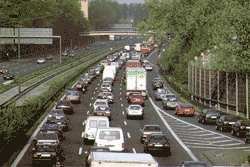The Computer Minds the Commuter

A new computer model of highway traffic flow that takes drivers’ expectations into account reproduces more real world traffic phenomena than any before it, say researchers publishing in the 11 June issue of PRL. The model gives virtual drivers the option of cruising cautiously or speeding forward optimistically based on what they think the car ahead is about to do. Previous models haven’t accounted for driver psychology in such a direct way. The new model could help improve real-time traffic forecasts, such as those German drivers consult before heading out onto the Autobahn.
As the amount of traffic data exploded in the early 1990s, researchers were surprised to find that traffic showed three phases, reminiscent of matter’s phases: Cars flow freely and quickly, with large gaps between them, like atoms in a gas, or they become jammed together like atoms in a solid. In between the two is the liquid-like, “synchronized” phase, in which cars are locked into an intermediate speed.
Statistical physics–which describes matter based on the behavior of many individual atoms–seemed a promising way to model traffic behavior. In 1992 Michael Schreckenberg, of the University of Duisburg-Essen in Germany, and Kai Nagel, now of the Technical University of Berlin, successfully reproduced some traffic data using statistical physics concepts in a so-called cellular automata model [1]. Such models consist of points on a grid that change their state based on the properties of neighboring points, and in traffic models, the points represent cars. Researchers have by now constructed numerous variations on this model, but most reproduce just the free flow and jammed phases accurately, or include unrealistic assumptions such as infinitely fast braking, says Schreckenberg.
Schreckenberg and his colleagues added two new features into their latest version to make it more realistic. First, the simulated cars can’t change speeds instantly; braking must be gradual. Second, drivers “overreact” to local road conditions. If the car ahead of a driver has room to speed up, the driver speeds up in anticipation. If not, the driver remains at a lower speed. “That is what people really do,” explains Schreckenberg.
The team simulated a single-lane road with an on-ramp that has a traffic light, and they gradually increased the density of cars. With increasing density the model reproduced all three phases more faithfully than previous models, according to Schreckenberg. It also generated a convincing version of the transition from synchronized flow to a growing jam called the “pinch effect.” In this phenomenon, clusters of cars entering the busy road generate “waves” of slowed or stopped clusters along the main roadway. These waves propagate backward from the on-ramp and can eventually fuse into one long traffic jam. Other models have reproduced this effect, but they were based on contrived assumptions about driver behavior that were chosen mainly because they worked, says Schreckenberg. He believes his group’s “overreaction” behavior more accurately reflects real driver psychology. The result could help engineers improve traffic forecasts and improve control over traffic lights at on-ramps, he says.
James Banks, a transportation researcher at San Diego State University, points out that older traffic models–those before cellular automata–probably included driver reactions in other ways, and it makes sense to include them in newer models. “It is commendable that they are starting with a description of the driver, but, so far, it’s a pretty simplistic one.” Carroll Messer of Texas A&M University in College Station says the model should improve understanding of the causes of jams.
–JR Minkel
JR Minkel is a freelance science writer in New York City.
References
- K. Nagel and M. Schreckenberg, “A cellular automaton model for freeway traffic,” J. Phys. I (France) 2, 2221 (1992)
More Information
Schreckenberg’s web site on the physics of traffic
A previous traffic model that included a form of driver reaction:B.S. Kerner, S.L. Klenov, and D. Wolf, J. Phys. A 35, 9971 (2002)


